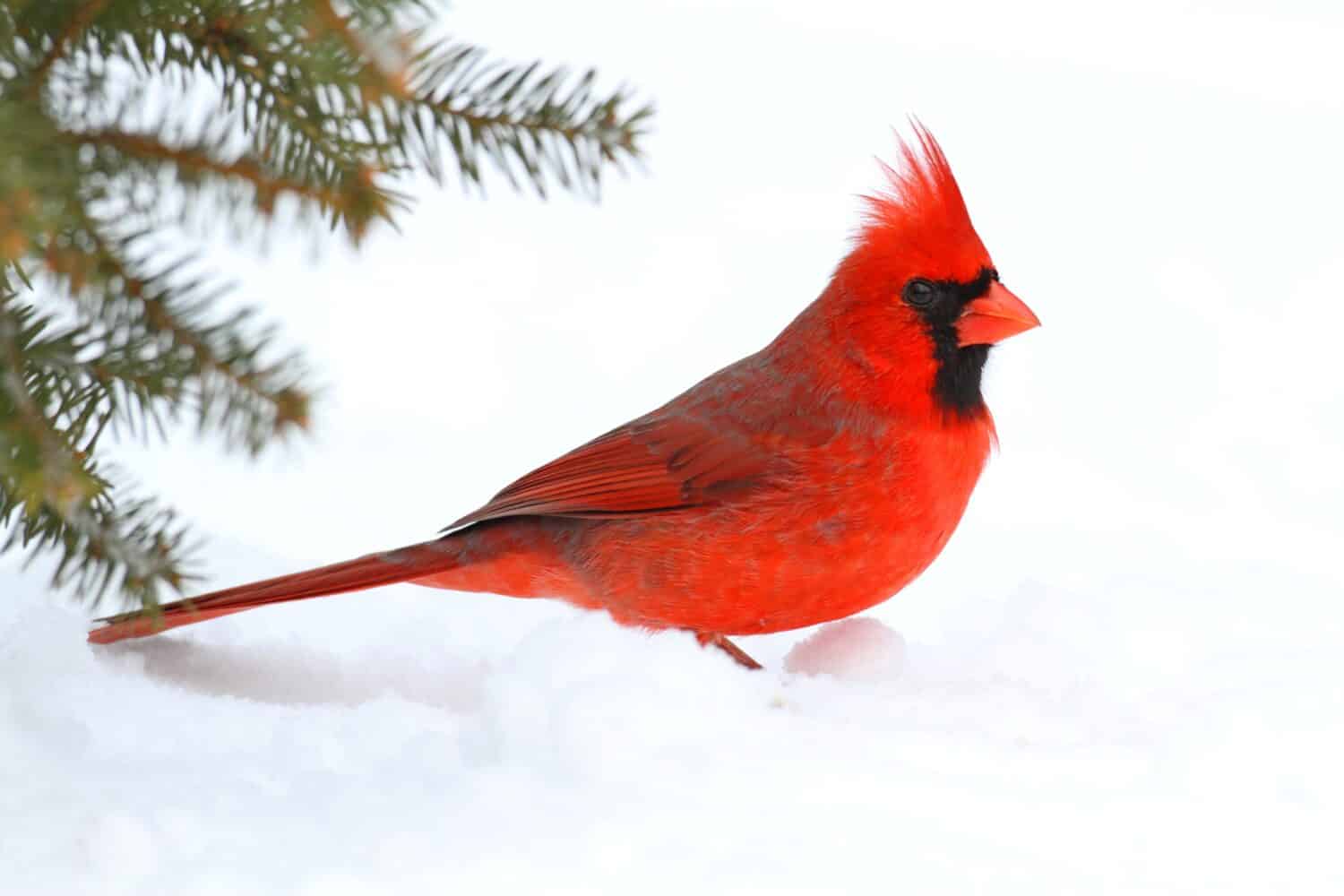Ohio is in the Midwestern region of the United States. It’s called “The Buckeye State”, for its Ohio buckeye trees. The geography of the state is primarily flat glacial plains. However, Southern and Eastern Ohio have the Appalachian Plateau and foothills of the Appalachian Mountains. The southern border of Ohio is defined by the Ohio River. To the north, Ohio also borders Lake Erie, one of the five Great Lakes. The various habitats of Ohio are home to many animal species. In particular, the state is home to many species of birds. According to the Ohio Department of Natural Resources, there are 427 species of birds in Ohio. Approximately 180 of these bird species nest in the state each year. One of these birds stands out as especially important to Ohioans, who made it their state bird. So, what is this lovable state bird?
The official state bird of Ohio is the northern cardinal. Northern cardinals are one of the 10 official state animals of Ohio. The Ohio general assembly adopted northern cardinals as the state bird in 1933. The state shares its official bird with six other states, including Illinois, Indiana, Kentucky, North Carolina, Virginia, and West Virginia. This article explores northern cardinals including what they look like, where they live, and what they eat. We will also cover an extremely rare northern cardinal that has yellow plumage!

Northern Cardinal (Cardinalis cardinalis) Facts
Ohio’s state bird, the northern cardinal, is also called a redbird or simply, cardinal. Northern cardinals have 19 subspecies in the Cardinalidae family, which includes species of cardinals, grosbeaks, and buntings. In this section, we will explore what northern cardinals look like, where they live, what they eat, and how they nest. We will also cover how to attract more northern cardinals to your yard using their favorite foods.
What Do Cardinals Look Like?

Male cardinals are bright red, while females are soft brown with red accents.
©Bonnie Taylor Barry/Shutterstock.com
Northern cardinals have a crimson red plumage, short bills, and long tails. However, females have a different plumage from males. The iconic crimson-red plumage and black mask that northern cardinals are known for is only seen in males. Females feature gray or brown plumage with red accents. However, both males and females have bright orange beaks. All young northern cardinals have similar plumage to adult females until they begin to molt and grow their adult feathers. At this point, males develop their crimson-red coloration.
Northern cardinals are mid-sized songbirds. Their bodies are 8.3–9.3 inches long, and their wingspans are 9.8–12.2 inches. Adults weigh between 1.19–2.29 ounces, with the average weighing 1.58 ounces, or the equivalent of eight U.S. quarters.
Though extremely rare, the “yellow morph” northern cardinal does not develop its normal crimson plumage, but instead develops bright golden yellow feathers. These rare birds are distinct from yellow cardinals, a species that lives in South America.

Rare yellow northern cardinals lack the enzyme that creates the red pigment of typical northern cardinals.
©Chase D’animulls/Shutterstock.com
Where Do Cardinals Live?
Northern Cardinal Distribution
Northern cardinals live year-round in the Midwest and Eastern United States, as well as in Eastern Mexico. They also live in Southern Ontario, Southern Quebec, New Brunswick, and Nova Scotia. Northern cardinals are named so because they are the northernmost species of cardinals. Amazingly, northern cardinals do not migrate. Unlike many other songbirds, who must migrate to avoid harsh winters, cardinals stay in colder places during winter. In fact, they are uniquely able to tolerate cold northern temperatures. These birds have several ways to survive the cold. First, they fluff up their soft down, which are fluffy feathers underneath a bird’s primary feathers. They help provide insulation. Secondly, northern cardinals generate heat by tensing their muscles. Finally, they can slightly drop their body temperature in order to survive extreme cold.
Ohio’s state bird is abundant in the state of Ohio. Northern cardinals especially stand out during Ohio’s snowy winters. Since they do not molt to a duller plumage for winter, their crimson-red plumage stands out against the white snow.

Ohio’s state bird has the amazing ability to survive harsh northern winters.
©Steve Byland/Shutterstock.com
Northern Cardinal Habitat
Northern cardinals are incredibly adaptable and live in a range of habitats, like woodlands, shrublands, city parks, and wetlands. They are also a common backyard bird, and many people choose to attract them with bird seed.
What Do Cardinals Eat?
The diet of northern cardinals is highly varied, though mainly plant matter. However, mothers feed their young a diet of mainly insects. As adults, they eat a wide range of seeds, fruits, and insects, finding most of their food on the ground.
If you want to attract northern cardinals to your yard with birdseed, it is important to know their favorite foods. They enjoy sunflower seeds, safflower seeds, crushed peanuts, and cracked corn. In order to attract Ohio’s state bird, try sprinkling these favorite foods around your yard.
Ohio’s State Bird Nesting
Northern cardinals nest in the spring. They typically have two to three broods per year. Northern cardinals typically mate for life, but occasionally pairs will separate. During courtship, males and females may sing together. Also, males may feed females during courtship. When it is time to nest, females build nests 3-10 feet off the ground in shrubs or trees. The nests are primarily made of twigs, bark, and weeds. Females sing before nesting, while males sing to defend their nests. Additionally, males will attack other males who enter the territory.
Northern cardinals lay between two and five eggs. The eggs are white, sometimes slightly pale blue or green with brown or purple spots. Females incubate the eggs for 12-13 days. Males and females both feed the chicks, though it is common for a male to feed fledglings while the female begins another nesting attempt. Only 9-10 days after hatching, the young are ready to leave the nest.
Interestingly, cowbirds will parasitize northern cardinal nests by laying eggs at the cardinal nesting site. The cardinals then incubate the eggs and raise the chicks alongside their own.
Ohio’s State Bird Song
Northern cardinals are a species of songbirds, which is a type of perching bird. Perching birds are the order Passeriformes. Songbirds are a suborder of Passeriformes called Passeri. What makes songbirds unique is a highly developed vocal organ called a syrinx. Songbirds use their songs to communicate their identity and location to other birds. They also use mating songs to attract mates. Also, alert calls let other birds know that predators are nearby. It is a common misconception that only male songbirds sing. However, in most species of songbirds, both sexes sing.
The northern cardinal has various songs and calls, which feature repeated patterns. They also have a short alarm call that they use to alert each other to nearby predators.
Northern Cardinal Predators
The northern cardinal has several predators, including hawks, falcons, eagles, and owls. Additionally, snakes, squirrels, chipmunks, blue jays, and crows will eat eggs and chicks.
The photo featured at the top of this post is © Steve Byland/Shutterstock.com
Thank you for reading! Have some feedback for us? Contact the AZ Animals editorial team.






